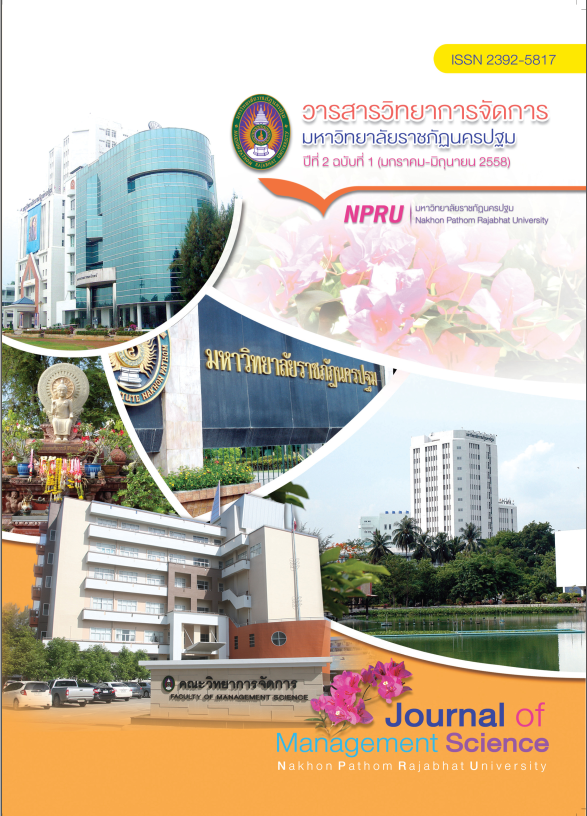The Factor Model of Management for Development of Organization Commitment of Personal in Physical Education Institutes in Thailand
Main Article Content
Abstract
The purpose of this research is to (1) influence organization’s factors commitment of staff in the Institute of Physical Education (2) Organizational Commitment. Personnel of the Institute of Physical Education in Thailand and 3. The model managing to make a commitment to the organization of the
Institutes of Physical Education in Thailand. The population including officials from the Institute of Physical Education, 17 campuses of 914 people using a sample size formula of Taro Yamane is a sample of 315 samples randomly oriented class. And in-depth interview the admiration 15 persons in this
organization.
The results are summarized.
The results showed that the majority were female. 54.00 per cent were married. 58.73 per cent of graduate degree. 81.90 per cent are located in the most 5-6 percent at the Institute of Physical Education Commissioner 40.95 to most respondents. Sukhothai from campus Representing 8.57 percent of respondents youngest is 21 years old and most of 60 years, with an average of
42 years of experience by ranging from 1-39 years, with an average of 17.41 years of work experience.
The analysis of the organizational commitment of the Institute of Physical Education in Thailand is influenced directly by the leadership (β = 0.86), perceived unfairness in the organization (β = 0.52) organizational climate (β = 0.11), and Cultural Organization (β = 0.08), respectively, while the leadership of the organization of the Institute of Physical Educationin Thailand. This is influenced by the perceived fairness of the organization (γ = 0.61) organizational climate (γ = 0.23) and Cultural Organization (γ = 0.17),respectively.
Article history : Accepted 28 April 2015
SIMILARITY INDEX = 7.39
Article Details
The views and opinions of the article appearing in this journal are those of the author. It is not considered a view and responsibility of the editorial staff.
References
ชฎาภา ประเสริฐทรง. (2541). ความผูกพันต่อสถาบันของนักศึกษา มหาวิทยาลัยหัวเฉียวเฉลิมพระเกียรติ. วิทยานิพนธ์ การบริหารการศึกษามหาบัณฑิต. สมุทรปราการ : มหาวิทยาลัยหัวเฉียวเฉลิมพระเกียรติ.
นงเยาว์ แก้วมรกต. (2542). ผลของทัศนะต่อบรรยากาศองค์การที่มีต่อความผูกพันต่อองค์การของบุคลากรบุคคลในเขตกรุงเทพมหานครและปริมณฑล. วิทยานิพนธ์การจัดการมหาบัณฑิตสาขาการจัดการทรัพยากรมนุษย์, มหาวิทยาลัยธรรมศาสตร์.
นฤเบศร์ สายพรหม. (2548). ความสัมพันธ์ระหว่างการรับรู้ความยุติธรรมในองค์การความผูกพันต่อองค์การกับพฤติกรรมการเป็นสมาชิกที่ดีในองค์การของบุคลากรในมหาวิทยาลัยเอกชนแห่งหนึ่ง. วิทยานิพนธ์วิทยาศาสตรมหาบัณฑิต สาขาวิชาจิตวิทยาอุตสาหกรรม, มหาวิทยาลัยเกษตรศาสตร์.
วิเชียร วิทยอุดม. (2547). พฤติกรรมองค์การ. กรุงเทพมหานคร : ธีระฟิล์ม และไซแท็กซ์.
ศิษฐ์ ฤทธิบุญไชย. (2553). ตัวแบบการจัดการองค์การแห่งความเป็นเลิศของกรมราชทัณฑ์. ปรัชญาดุษฎีบัณฑิต. สาขาวิชาการจัดการ.บัณฑิตวิทยาลัยมหาวิทยาลัยสยาม.
สัญญา สัญญาวิวัฒน์. (2551). สังคมวิทยาองค์การ. พิมพ์ครั้งที่ 3. กรุงเทพมหานคร : สำนักพิมพ์จุฬาลงกรณ์มหาวิทยาลัย.
สุนทร วงศ์ไวศยวรรณ. (2540). วัฒนธรรมองค์กร. กรุงเทพฯ : โฟร์เพซ.
สุรินทร์ ชาลากูลพฤฒิ. (2551). ปัจจัยที่ส่งผลต่อความผูกพันกับองค์การของบุคลากรต้อนรับบนเครื่องบิน (หญิงล้วน) บริษัท สายการบินนกแอร์ จำกัด. วิทยานิพนธ์ศึกษาศาสตรมหาบัณฑิต สาขาวิชาจิตวิทยาการแนะแนว, มหาวิทยาลัยศรีนครินทรวิโรฒ.
อารีย์ เพ็ชรรัตน์. (2540). การเปรียบเทียบการรับรู้ลักษณะวัฒนธรรมองค์การและความรู้สึกผูกพันต่อองค์การในองค์การธุรกิจประกันภัยไทย อเมริกัน และญี่ปุ่น. สาขาวิชาจิตวิทยาอุตสาหกรรมและองค์การ คณะศิลปศาสตร์ มหาวิทยาลัยธรรมศาสตร์.
Allen, N.J. and J.P. Meyer. (1990). The measurement and antecedents of affective,continuance, and normative commitment to the organization.The Journal of occupational Psychology, 63: 1-18.
Bowditch, J.L and A.F. Buono. (1994). A primer on organizational behavior. (3rd ed.). NewYork: John Wiley & Sons.
Gilliland, S.W. and J.C. Langdon. (1998). “Creating Performance Management Systems That Promote Perceptions of Fairness.” Performance Appraisal. 209-243. Edited by J. W. Smither San Francisco, CA : Jossey-Bass.
Hofstede, G. (1997). Cultures and Organizations: Software of the Mine. New York : McGraw Hill Companies, Inc.
Newman, K. L. (1996). Culture and congruence : The Fit Between Management Practices and National Culture. Journal of International Business. 27 (4): 753-771.
Podsakoff, P.M., Mackenzie, S.B., Moorman, R.H. & Fetter, R. (1990). “Transformational leader behavior and their effects on followers trust on leader, Satisfaction, and organizational citizenship behaviors”. Leadership Quarterly, 1(2), 107-142.
Stringer, R.A. (2002). Leadership and Organizational Climate : The Cloud Chamber Effect. Pennsylvania State University. Prentice Hall.
Yukl, G. (1998). Leadership in organizations. (4th ed.), Englewood Cliffs, NJ : Prentice Hall.


